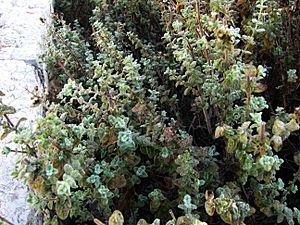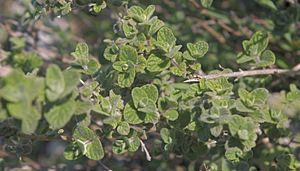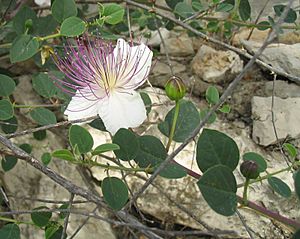Ezov facts for kids
Ezov (pronounced "eh-ZOV") is the ancient Hebrew name for a special plant mentioned in the Bible. In many English Bibles, this word is translated as "hyssop." This plant was very important for religious ceremonies long ago.
People believed ezov had a nice smell and could help make things clean. Many experts think ezov was a type of wild herb. This could include plants like za'atar, which often refers to marjoram, oregano, or thyme. These herbs grow naturally in Israel and have a strong, pleasant scent. They were also easy to gather and use for sprinkling.
Contents
What Was Ezov?
The Bible describes ezov as a small plant that grew on or near walls. It had a strong, pleasant smell.
Different Ideas About Ezov
For a long time, people have wondered exactly what plant ezov was.
- Some ancient Jewish thinkers, like Maimonides, believed ezov was the same as za'atar. This makes sense because za'atar herbs have a strong smell and were used for cleaning.
- The New Testament, specifically the book of John, mentions "hyssop" being used to offer vinegar to Jesus during his crucifixion. However, other Bible books (Matthew and Mark) just call it a "reed" or "stick."
- Some scholars think that the plant Origanum (a type of oregano) might have been too short to reach Jesus's mouth on the cross.
- Because of this, some experts suggest ezov might have been the caper plant (Capparis spinosa). Arabs call the caper plant azaf. Caper plants grow all around the Mediterranean region and were also thought to have cleansing properties.
Ezov and Health
Some people have even suggested that a verse in Psalm 51 ("Purge me with hyssop, and I shall be clean:") might be an early idea about using plants for medicine. They think it could relate to Penicillium, which is where the medicine penicillin comes from.
Ezov's Special Uses
Ezov was used in several important rituals described in the Bible.
The Passover Ritual
The Israelites used ezov during the first Passover in Egypt. They were enslaved at the time. They used ezov to sprinkle lamb's blood on their doorposts. This was a sign so that God would "pass over" their homes when he brought a plague upon the Egyptians.
Cleaning Rituals
After settling in Israel, the Israelites used ezov regularly for other cleaning rituals.
- It was used in a special ceremony to cleanse someone who had been sick with tzaraath (a skin condition often translated as leprosy).
- It was also used for general ritual purification, which means making something or someone spiritually clean.
- In the book of Psalms, sprinkling with ezov is used as a way to talk about making one's heart pure and clean.
Modern Practices
Today, the Roman Catholic Church and some other Christian groups still use a practice similar to the biblical use of ezov. They interpret "ezov" as "hyssop." They sprinkle water to ritually cleanse objects, churches, and people. This ritual is called aspersion and is part of a service called the Asperges.




